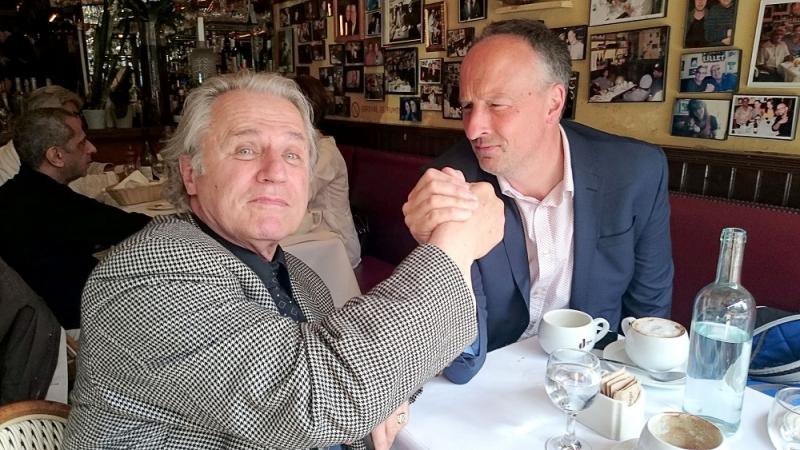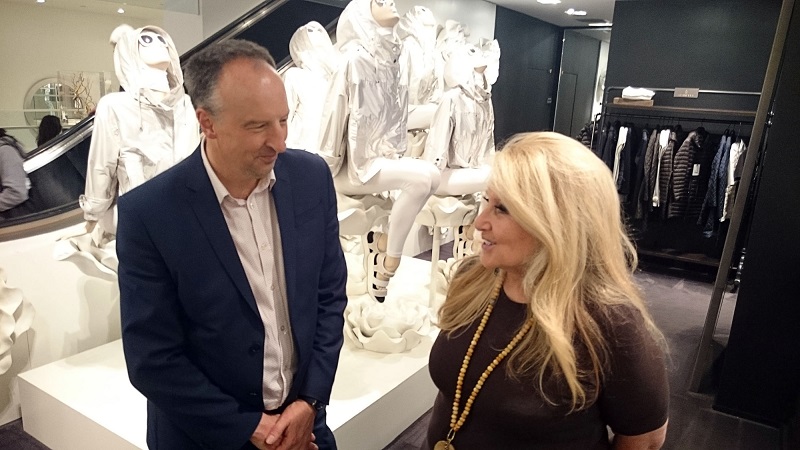A Day in the Life of Andy Warhol, BBC Four | reviews, news & interviews
A Day in the Life of Andy Warhol, BBC Four
A Day in the Life of Andy Warhol, BBC Four
24 hours in the king of Pop Art's shoes

It was suggested more than once during this adventure in Warhol-world that Andy Warhol himself was the artist’s greatest achievement. It’s a neat sentiment if not an original one, and while it may well be true, it didn’t bode well for a documentary in search of the “real” Andy Warhol.
In the event, however, the whole thing was so thoroughly entertaining that such objections seemed prissy and unsporting, encounters with an array of aged Factory regulars providing a rare hour of fun. Presenter Stephen Smith, usually at home on Newsnight, maintained an air of good-humoured scepticism pretty much throughout, keeping the whole thing well clear of hagiography.
There were occasional glimpses of a more vulnerable, recognisably human character
Even so, as Smith’s “24 hours in Andy-time” got started just after midnight with Warhol shooting one of his most notorious films, a five-hour marathon featuring his friend and lover John Giorno fast asleep, Smith seemed momentarily overwhelmed. Meeting Giorno and his now legendary bed, Smith enquired: “Would it be OK for me to touch the storied bed? I don’t need gloves?” Giorno was tickled pink, replying: “Touch it, do anything that you want to”. Sure enough, Smith crouched down to prod the mattress, mumbling something about checking it for springiness.
While Warhol himself was finally sleeping – a minor miracle according to Giorno, who said he “took speed by the handful” – in the townhouse he shared with his mother and two dozen Siamese cats, Gerard Malanga, “the Factory stud”, was slaving away on $1.25 an hour, working on the silkscreen prints for which Warhol is perhaps best known today. Smith’s meeting with Malanga in a New York bistro was fascinating, not least because it demonstrated all too vividly how even the wildest of youths must submit, eventually, to cholesterol problems and early bedtimes (main picture).
It was difficult to get the measure of Malanga, who was by turns frank and evasive, describing his paltry wages as “embarrassing” but deftly outmanoeuvring his interviewer when asked whether his contribution to the Warhol project had been properly acknowledged. Malanga was far from alone in his loyalty to Warhol, and the all-too predictable comparison between Warhol’s Factory and a king holding court seemed hard to refute.
 Time and again his old associates leapt to his defence. “Little Joey” Freeman, the youngest member of the Factory, employed by Warhol to get him out of bed at around lunchtime every day, described how he lost weight to fit in with the Factory’s “ideal”, but denied that there was any pressure to do so. Jane Holzer (pictured above), whose appearance in 11 of Warhol’s Screen Tests rescued her from life as a bored housewife, dismissed the suggestion that Warhol dropped stars as quickly as he created them.
Time and again his old associates leapt to his defence. “Little Joey” Freeman, the youngest member of the Factory, employed by Warhol to get him out of bed at around lunchtime every day, described how he lost weight to fit in with the Factory’s “ideal”, but denied that there was any pressure to do so. Jane Holzer (pictured above), whose appearance in 11 of Warhol’s Screen Tests rescued her from life as a bored housewife, dismissed the suggestion that Warhol dropped stars as quickly as he created them.
For all this, there were occasional glimpses of a more vulnerable, recognisably human character, and Warhol’s reliance on the opinions, ideas and reassurance of those around him was made apparent. One of his closest confidantes was Brigid Berlin, whose lengthy and bizarre phone-calls with Warhol were recreated for the camera: “Everyone thinks Andy was so quiet. Well I can contradict that perfectly, because he never shut up.” Warhol’s nephew, strikingly similar in appearance to his uncle, described how the artist had a crucifix above his bed, his regular attendance at church part of a private homelife that he kept strictly separate from his life as an artist.
As Smith finished the day embroiled in another night-time filming stint, it was hard to say whether we had really learned much at all about the "real" Andy Warhol. What was clear though, was that this hardly seemed to matter. Real or not, is there ever likely to be a more compelling figure than Andy Warhol?
rating
Share this article
The future of Arts Journalism
You can stop theartsdesk.com closing!
We urgently need financing to survive. Our fundraising drive has thus far raised £33,000 but we need to reach £100,000 or we will be forced to close. Please contribute here: https://gofund.me/c3f6033d
And if you can forward this information to anyone who might assist, we’d be grateful.

Subscribe to theartsdesk.com
Thank you for continuing to read our work on theartsdesk.com. For unlimited access to every article in its entirety, including our archive of more than 15,000 pieces, we're asking for £5 per month or £40 per year. We feel it's a very good deal, and hope you do too.
To take a subscription now simply click here.
And if you're looking for that extra gift for a friend or family member, why not treat them to a theartsdesk.com gift subscription?
more TV
 Your Friends & Neighbors, Apple TV+ review - in every dream home a heartache
Jon Hamm finds his best role since 'Mad Men'
Your Friends & Neighbors, Apple TV+ review - in every dream home a heartache
Jon Hamm finds his best role since 'Mad Men'
 MobLand, Paramount+ review - more guns, goons and gangsters from Guy Ritchie
High-powered cast impersonates the larcenous Harrigan dynasty
MobLand, Paramount+ review - more guns, goons and gangsters from Guy Ritchie
High-powered cast impersonates the larcenous Harrigan dynasty
 This City is Ours, BBC One review - civil war rocks family cocaine racket
Terrific cast powers Stephen Butchard's Liverpool drug-ring saga
This City is Ours, BBC One review - civil war rocks family cocaine racket
Terrific cast powers Stephen Butchard's Liverpool drug-ring saga
 The Potato Lab, Netflix review - a K-drama with heart and wit
Love among Korean potato-researchers is surprisingly funny and ideal for Janeites
The Potato Lab, Netflix review - a K-drama with heart and wit
Love among Korean potato-researchers is surprisingly funny and ideal for Janeites
 Adolescence, Netflix review - Stephen Graham battles the phantom menace of the internet
How antisocial networks lead to real-life tragedy
Adolescence, Netflix review - Stephen Graham battles the phantom menace of the internet
How antisocial networks lead to real-life tragedy
 Drive to Survive, Season 7, Netflix review - speed, scandal and skulduggery in the pitlane
The F1 documentary series is back on the pace
Drive to Survive, Season 7, Netflix review - speed, scandal and skulduggery in the pitlane
The F1 documentary series is back on the pace
 A Cruel Love: The Ruth Ellis Story, ITV1 review - powerful dramatisation of the 1955 case that shocked the public
Lucy Boynton excels as the last woman to be executed in Britain
A Cruel Love: The Ruth Ellis Story, ITV1 review - powerful dramatisation of the 1955 case that shocked the public
Lucy Boynton excels as the last woman to be executed in Britain
 Towards Zero, BBC One review - more entertaining parlour game than crime thriller
The latest Agatha Christie adaptation is well cast and lavishly done but a tad too sedate
Towards Zero, BBC One review - more entertaining parlour game than crime thriller
The latest Agatha Christie adaptation is well cast and lavishly done but a tad too sedate
 Bergerac, U&Drama review - the Jersey 'tec is born again after 34 years
Damien Molony boldly follows in the hallowed footsteps of John Nettles
Bergerac, U&Drama review - the Jersey 'tec is born again after 34 years
Damien Molony boldly follows in the hallowed footsteps of John Nettles
 A Thousand Blows, Disney+ review - Peaky Blinders comes to Ripper Street?
The prolific Steven Knight takes us back to a squalid Victorian London
A Thousand Blows, Disney+ review - Peaky Blinders comes to Ripper Street?
The prolific Steven Knight takes us back to a squalid Victorian London
 Zero Day, Netflix review - can ex-President Robert De Niro save the Land of the Free?
Panic and paranoia run amok as cyber-hackers wreak havoc
Zero Day, Netflix review - can ex-President Robert De Niro save the Land of the Free?
Panic and paranoia run amok as cyber-hackers wreak havoc
 The White Lotus, Series 3, Sky Atlantic review - hit formula with few surprises but a new bewitching soundtrack
Thailand hosts the latest bout of Mike White's satirical takedown of the rich and privileged
The White Lotus, Series 3, Sky Atlantic review - hit formula with few surprises but a new bewitching soundtrack
Thailand hosts the latest bout of Mike White's satirical takedown of the rich and privileged

Add comment